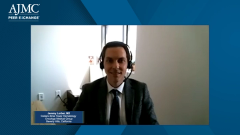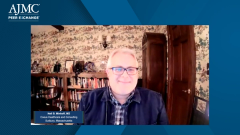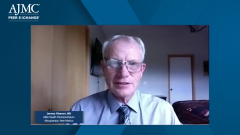
Anti–B-Cell Therapy for Cold Agglutinin Disease
The rationale for treating patients with cold agglutinin disease with anti–B-cell therapies such as rituximab, bortezomib, or daratumumab based on supporting data.
Episodes in this series

Neil Minkoff, MD: Dr Lorber, I’m going to switch to you mostly because I’ve forced your colleague to do too much work over the last 5 minutes. I apologize for that. I want to make sure we’re all on the same page. Maybe you could discuss a little the role of anti–B-cell therapies, which ones you’d use, how you choose the patients for them, and so on.
Jeremy Lorber, MD: Any patient who has symptoms that can’t be managed just with simple cold avoidance should be strongly considered for anti–B-cell therapy. Some of the acute treatments we mentioned recently, like plasmapheresis and transfusions, are very short term. They don’t treat the underlying pathophysiology of the disease, and the effects will not be long-lasting. The underlying thought is that cold agglutinin disease is caused by a B-cell clone in the marrow, even without an overt lymphoma, so we treat it similarly to a lymphoma, even though we’re not labeling the patient with a lymphoma. Rituximab, the monoclonal CD20 antibody, is at the cornerstone of treatment, with or without chemotherapy added to it. We’re all familiar with rituximab. It’s been used in hematologic malignancies for many years. It’s even available as a biosimilar now. It’s available as a subcutaneous injection. There have been a lot of single-arm data, usually retrospective, showing that patients have a high response rate to rituximab-based treatment and that therapy can have long durations of responses. There was a retrospective study recently published in Blood by [Sigbjørn] Berentsen, et al, in 2020 showing that the response rate was just under 80% for the rituximab-bendamustine combination. About half of patients had a complete response rate. What impressed me the most was the durability of response for a treatment that’s given only for a few months. At 5 years, the response rate remained in the 70% range, and the median duration of response for those who responded was over 7 years.
Neil Minkoff, MD: Can I ask a clarifying question about that to make sure we’re all on the same page? How did the paper define complete response rate? I want to make sure folks who are listening who don’t treat this know exactly what you’re getting at.
Jeremy Lorber, MD: This paper, and often in cold agglutinin disease [CAD] studies, is defined by a sufficient increase in hemoglobin and a complete lack of need for transfusion. If a patient was requiring transfusion prior, they no longer require any.
Neil Minkoff, MD: I just wanted to make sure that we were all on the same page on that. Sorry, I didn’t mean to cut you off.
Jeremy Lorber, MD: Unlike some hematologic malignancies, complete response here doesn’t involve bone marrow biopsies and looking at any kind of B-cell clone. It’s just clinical response.
Neil Minkoff, MD: There are other products that are being studied besides rituximab.
Jeremy Lorber, MD: That’s correct. There are existing products such as bortezomib, which is approved in multiple myeloma. And there are some novel agents targeting a complement cascade that aren’t approved for any condition but have been studied and have data specifically in CAD.
Neil Minkoff, MD: Do they look promising?
Jeremy Lorber, MD: Yes. An interesting study with bortezomib–again, used as a common treatment in the plasma cell cancer, multiple myeloma–published in 2018 showed that patients who were refractory to at least 1 prior treatment, who received only a single course of bortezomib, so that’s under 2 weeks, had about a one-third response rate. One-third of the patients responded. What’s remarkable is that that’s an extremely short duration of treatment. When bortezomib is used in myeloma or some lymphomas, we typically give it for months. To achieve what seems like maybe a modest response rate in the low 30% range is remarkable for a group that received such a short duration of treatment. It’s possible a longer duration of treatment would have given a higher response and a more durable response. Another treatment that’s approved in multiple myeloma, which again makes logical sense because it targets malignant plasma cells, is daratumumab. It’s a monoclonal antibody to CD38. There’ve been case reports showing patients with severe CAD responding to daratumumab. These patients are refractory to other treatments. It also seems to improve the cytokine profile in these patients, which is a hint that it may improve the inflammatory pathways occurring in these patients.
Neil Minkoff, MD: I’ll open this up to both of our clinicians, and then I want to bring the payers in. Do you have experience working with these kinds of products? How do you choose which patients get which product? If that doesn’t sound too naïve.
Jeremy Lorber, MD: All 3 products—rituximab with chemotherapy, bortezomib, and daratumumab—are commonly used because the diseases where they have the specific approval, lymphomas and myeloma, are much more prevalent than CAD. Clinicians treating blood cancers will be very comfortable with all these medications. They’re not new. The toxicity profile is well known and generally thought to be acceptable. The way I decide between them is that rituximab has the most data, so patients who need treatment will start with rituximab. If they can tolerate it, I add the chemotherapy bendamustine to it. The other agents with less data, like bortezomib and daratumumab, I reserve for patients who are refractory to rituximab-based treatments because they have less data in CAD specifically.
Mihir Raval, MD, MPH: Correct. To expand on that, if I do have somebody who’s older and I don’t feel comfortable treating them with a chemotherapeutic agent, I try to do the rituximab monotherapy only. If they achieve response, which sometimes lasts up to 11, 12 months or longer, and they’re progressing again, then you can rechallenge them with the same agent, so you don’t have to change the treatment if they have good sufficient duration of response. When Velcade [bortezomib] was studied, they used IV [intravenous], but nowadays we don’t use IV Velcade because of the high risk of neuropathy. The common practice is to use Velcade with more subcutaneous administration. That adds to that ease of administration with less risk of neuropathy for those patients.
Transcript edited for clarity.
Newsletter
Stay ahead of policy, cost, and value—subscribe to AJMC for expert insights at the intersection of clinical care and health economics.































































